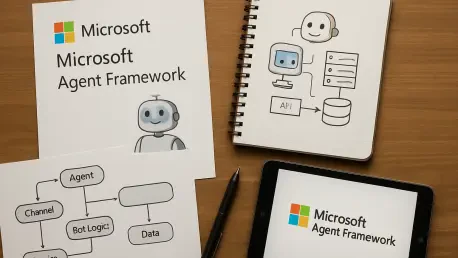In a world where artificial intelligence is rapidly reshaping how businesses operate, the emergence of a groundbreaking platform from Microsoft is capturing the attention of developers and industry leaders alike, marking a significant shift in enterprise technology. The Microsoft Agent Framework represents a bold leap forward by integrating two distinct AI development systems—Semantic Kernel and AutoGen—into a unified, powerful toolset designed to transform enterprise applications. This innovative framework promises to streamline the creation of AI-driven solutions by combining structured automation with dynamic, adaptive interactions, all while maintaining scalability and accessibility. Imagine a system that not only automates routine business tasks with precision but also fosters creative problem-solving through collaborative agent models. Hosted as an open-source platform, it invites global collaboration and adaptability across diverse environments. This article explores the key aspects of this framework, delving into its unique features, its impact on AI orchestration, and its potential to redefine how enterprises leverage technology for growth and efficiency.
Bridging Diverse AI Philosophies
The strength of the Microsoft Agent Framework lies in its ability to merge two contrasting approaches to AI development into a cohesive system. Semantic Kernel offers a structured methodology, focusing on predefined prompts and agent chains to automate established business processes with reliability. This makes it ideal for organizations that need consistent, repeatable outcomes in their operations. In contrast, AutoGen brings a research-driven perspective, utilizing language models to enable dynamic agent interactions through flexible, open-ended prompts. This allows for innovative responses to complex, evolving challenges. By integrating these two platforms, the framework provides a balanced solution that caters to both predictable tasks and exploratory scenarios, ensuring businesses can address a wide spectrum of needs without switching between disparate tools.
This fusion creates a versatile environment where enterprises can thrive. For instance, a company could use Semantic Kernel’s workflow capabilities to manage inventory systems with precision, while employing AutoGen’s adaptive models to brainstorm customer engagement strategies. Such duality empowers developers to craft tailored AI applications that align with specific organizational goals. The framework’s ability to support both structured and creative processes positions it as a unique asset in the competitive landscape of AI technology, enabling businesses to stay agile in an ever-changing market. This integration not only simplifies development but also broadens the scope of what AI can achieve in real-world applications.
Redefining AI Orchestration Models
At the core of the Microsoft Agent Framework is a sophisticated approach to orchestration, setting it apart in the realm of AI development. Workflow orchestration, derived from Semantic Kernel, focuses on chaining agents in a logical sequence to execute business processes seamlessly. This ensures that tasks like data processing or order fulfillment follow a clear, efficient path. Meanwhile, agent orchestration, inspired by AutoGen, introduces a range of dynamic models such as sequential, concurrent, group chat, hand-off, and magnetic workflows. These models facilitate diverse interaction patterns, from straightforward linear responses to intricate setups where agents collaborate or report to a supervisory agent. Such versatility allows the framework to mirror the complexities of real-world business challenges with remarkable accuracy.
The implications of this orchestration focus are profound for enterprise environments. Businesses can design AI systems that adapt to varied operational demands, whether it’s a simple task requiring a single agent or a multifaceted project needing collaborative input. For example, the group chat model enables agents to brainstorm solutions collectively, while the magnetic model introduces oversight for quality control. This capability transforms AI from a mere tool into a strategic partner, capable of navigating nuanced workflows. By offering multiple orchestration options, the framework ensures that companies can tailor their AI implementations to specific needs, enhancing both productivity and innovation across diverse sectors.
Harnessing Open-Source Innovation
A defining characteristic of the Microsoft Agent Framework is its open-source nature, hosted on GitHub, which fosters a collaborative spirit in AI development. This approach allows developers from around the globe to contribute ideas, share code, and experiment with new practices, driving rapid advancements. With accessible sample code and Codespace environments, the barrier to entry is significantly lowered, enabling even those new to AI to dive into creating applications. Furthermore, the framework’s independence from specific AI models or providers grants developers the freedom to select tools that best suit their projects, while staying aligned with emerging standards like the Model Context Protocol (MCP). This adaptability ensures that the platform remains relevant amid technological shifts.
Beyond development, the framework’s flexibility extends to deployment, supporting operations in local, cloud, or hybrid setups. This means businesses can choose the most cost-effective and efficient environment for their needs, whether running agents on-premises to reduce latency or leveraging cloud resources for scalability. Such versatility is crucial in a fast-evolving field where staying ahead requires constant adaptation. The open-source model not only democratizes access to cutting-edge AI tools but also builds a community-driven ecosystem where innovation thrives. As a result, enterprises can confidently invest in solutions that evolve alongside industry trends, securing their competitive edge.
Leveraging Cutting-Edge Technology
The Microsoft Agent Framework is designed with the future in mind, incorporating support for modern hardware and AI models to optimize performance. Notably, it embraces Neural Processing Units (NPUs) and small language models (SLMs), particularly in advanced devices like Copilot+ PCs. Although SLM availability for agent-specific tasks remains in early stages, the framework’s compatibility with both local and cloud-hosted models through platforms like Azure AI Foundry and GitHub Models paves the way for significant advancements in on-device processing. This dual approach reduces dependency on constant cloud connectivity, promising faster response times and lower operational costs for businesses seeking efficiency.
This forward-looking strategy highlights a commitment to harnessing the latest technological developments for practical use. By integrating with NPUs, the framework enables AI tasks to run directly on devices, cutting down latency and enhancing user experiences in real-time applications. For enterprises, this translates into cost savings and improved performance, especially in scenarios requiring immediate data processing. As SLM capabilities expand, the potential for localized AI solutions will grow, positioning the framework as a leader in edge computing trends. This focus on modern infrastructure ensures that businesses adopting the platform are equipped to handle tomorrow’s challenges with today’s tools.
Streamlining Development for All
Ease of use is a cornerstone of the Microsoft Agent Framework, particularly for developers looking to build robust AI applications efficiently. The updated AI Toolkit for Visual Studio Code, combined with integration into .NET 9 or later, simplifies the process of creating agents and orchestrating workflows. Developers can begin with a chat client to connect to models, define agent behaviors through carefully crafted prompts, and use tools like AgentWorkflowBuilder to structure complex tasks. This standardized approach leverages familiar hosting and deployment mechanisms within .NET, making it accessible to those already versed in the ecosystem while offering a clear starting point for newcomers.
For those transitioning from existing Semantic Kernel or AutoGen setups, a structured migration pathway is provided, though it involves updates to codebases and namespaces. This process, while requiring effort, ensures access to the framework’s enhanced capabilities, promising long-term benefits. The emphasis on developer-friendly tools reduces the learning curve, enabling faster adoption across teams of varying expertise. By prioritizing simplicity without sacrificing depth, the framework empowers a broader range of professionals to innovate, driving wider implementation of AI solutions in enterprise settings. This accessibility is key to democratizing advanced technology for practical, impactful use.
Paving the Way for Enterprise AI Solutions
Reflecting on the journey of the Microsoft Agent Framework, it becomes evident that its integration of Semantic Kernel and AutoGen marks a pivotal moment in AI development. The blend of structured automation with dynamic adaptability offers enterprises a powerful tool to address diverse operational needs. Its orchestration models, ranging from sequential tasks to complex group interactions, provide unmatched flexibility in tackling business challenges. The open-source foundation fosters a collaborative spirit, while support for modern hardware like NPUs ensures readiness for future advancements. Despite hurdles such as migration complexities and the need for precise prompt design, the framework stands out as a testament to thoughtful design and industry foresight. Moving forward, businesses should focus on strategic adoption, investing in training to master its features and experimenting with orchestration models to optimize workflows. Exploring partnerships within the open-source community could further enhance tailored solutions, ensuring that enterprises fully capitalize on this transformative platform’s potential.









